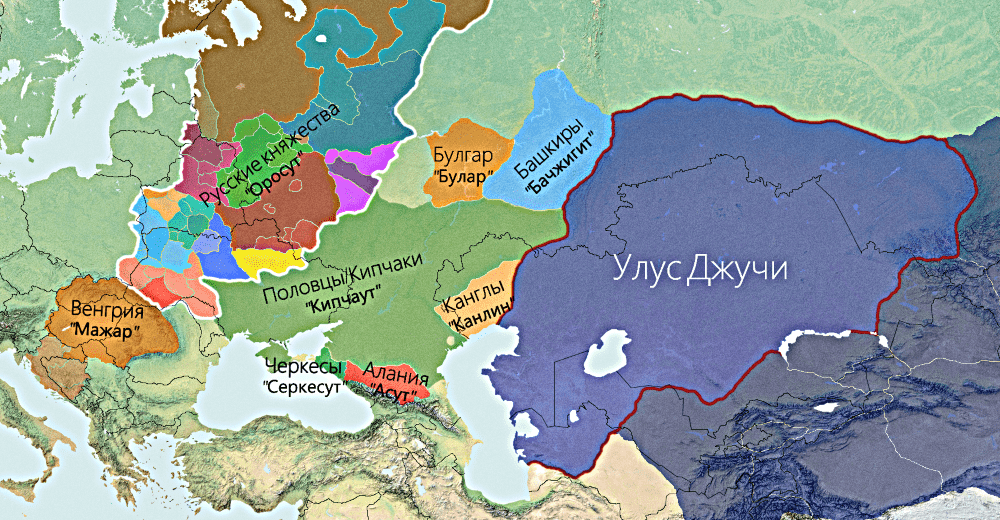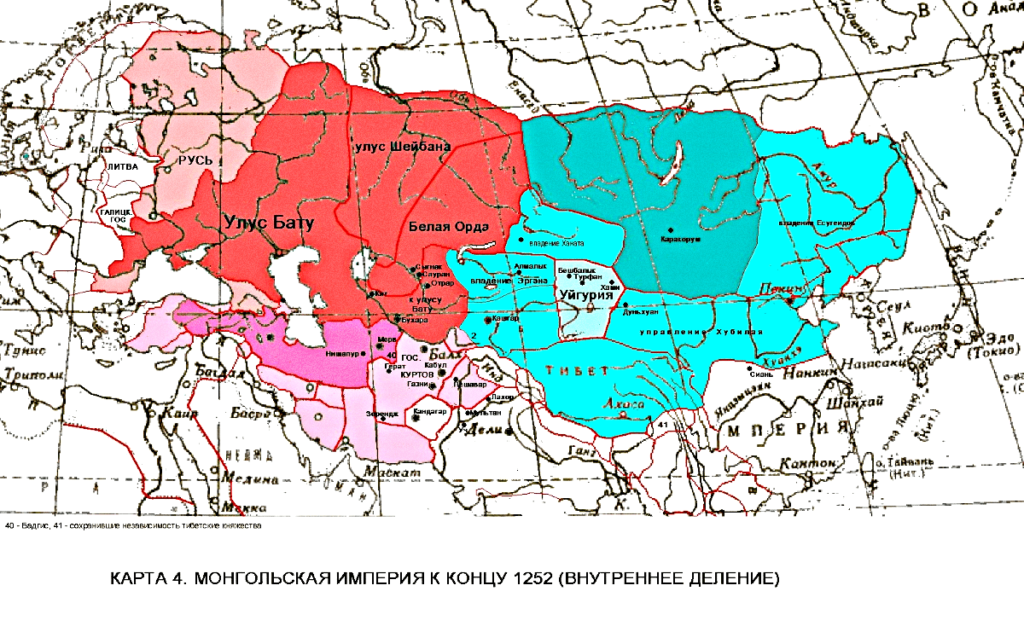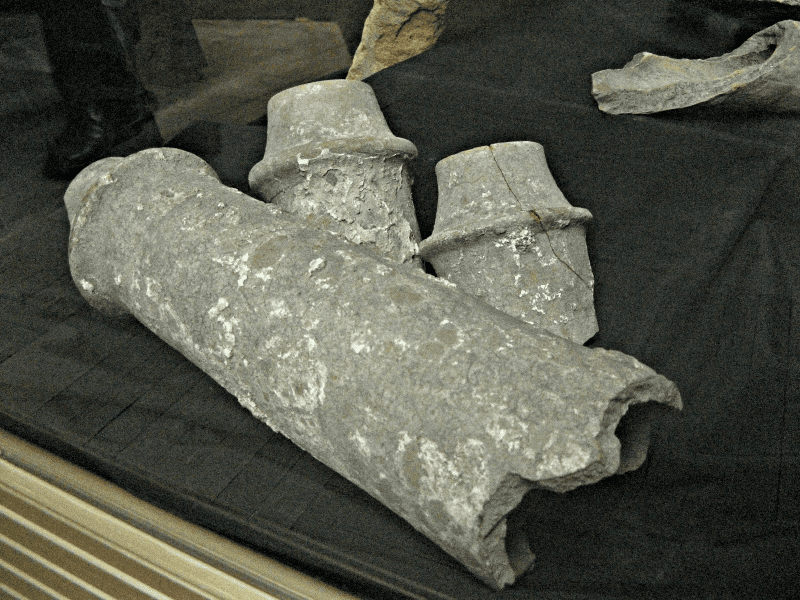Sarai-Batu — the capital of the Golden Horde, was located in the Astrakhan region, near the modern village of Selitrennoye (photo from open sources).

After the death of Juchi in 1225, a year later in 1226 by decision of his father Genghis Khan, the ulus of Juchi was headed by his 20-year-old second son Batu (1205-1256). Being an active nature, Batu was not satisfied with his father’s ulus, but decided to continue advancing to the West to conquer the western tribes of the Kipchaks.

Ulus Dzhuchi in 1225 (the future Golden Horde). The rest of the Mongol Empire is shown in dark blue.
In 1235-36 Batu, as a result of the so-called Western campaign, greatly expanded the lands of the Mongol Empire far to the West, and, in fact, founded in the steppes of Eastern Europe his own new ulus, which we traditionally call the Golden Horde. In 1243 Batu finished the conquest of the Eastern European territory and returned to the Volga region. Here he settled on the banks of the Volga, where, in fact, then the political center of the new state was formed. Thus, Batu’s ulus significantly exceeded the size of his father’s ulus, and Batu can be considered the first khan of the Golden Horde.

Although the Mongols were nomads, they realized the importance of cities. Batu Khan ordered the first capital of his ulus, Sarai-Batu, to be built on the Akhtuba River, a tributary of the Volga.

Sarai-Batu, on the photo is only a small reconstructed part of the once huge city.
At the peak of its development, its population was about 75 thousand people. The city was a truly international metropolis, where Mongols, Turks, Russians, Caucasians, Iraqis, Syrians, Greeks, etc. lived in separate quarters. This place was described by several explorers, among them the famous Moroccan traveler Ibn Battuta, who wrote in 1334 that it was «one of the most beautiful cities, full of people, with beautiful bazaars and wide avenues». He goes on to describe that it took them half a day to get from one part of the city to another. The city was a major stop on the trade route from Western Europe to China. The city also had several districts specializing in the production of metal, pottery, jewelry, glass, etc.

Some archaeological finds from Sarai-Batu, the capital of the Golden Horde
The city had a fairly developed water supply and sewerage system. The inhabitants used ceramic pipes for water supply.

Today we know that there were more than 100 cities in the Golden Horde. The largest of them were Sarai-Batu, Sarai-Berke, Crimea (Solkhat).
Disintegration
The Ulus Dzhuchid (Golden Horde) existed for 235 years, from 1224 to 1459. The factors that led to the disintegration of the Golden Horde were primarily internal conflicts and the emergence of influential regional leaders. After Batu’s lineage ended with the death of Berdibek in 1359, a period of turmoil began in the Horde. Berdibek himself, coming to power in 1357, ordered to kill all representatives of Batu Khan’s family who could be his real or potential rivals. In total, 12 of his relatives were killed, including his 8-month-old brother, whom Berdibek killed personally by hitting the infant to the ground.
Subsequently, the Horde was ruled by a succession of weak and ineffective khans who were unable to maintain control over the various territories and peoples within the ulus. The Horde also faced economic and military problems due to the growing power of neighboring states such as the Ottoman Empire and the Empire of Timur.

Also, the population of the Horde was diverse, with many different ethnic groups and languages. This diversity prevented the Khans from maintaining control and unity within the ulus. As a result, the Golden Horde began to break up into smaller states, each ruled by a regional leader or khan. These states, such as the Khanate of Kazan, the Crimean Khanate, and the Nogai Horde, were eventually absorbed by neighboring powers or became independent.
Overall, the Golden Horde was a complex multi-ethnic state that faced many problems. These problems eventually led to the fragmentation of the Horde and eventually to its disintegration.
The main factors that led to the disintegration of the Golden Horde are the following:
- Internal political instability with frequent change of power. In particular, for the entire history of the Horde in 235 years it was ruled by 64 persons of khans, who came to the throne a total of 79 times. More than two-thirds of them were not Chinggisids, the Mongol intellectual-ethnic component of the Chinggisids had already been largely Turkicized and Islamized for two or three generations. Disputes over succession to the throne between the ruling khans and their descendants weakened the centralized power of the Golden Horde. These conflicts often led to feuds and civil wars, which further fragmented the state. At the end of the 14th century, the Golden Horde disintegrated into several smaller khanates, each with its own ruler and political system.
- Two military campaigns against the Golden Horde led by Tamerlan (Timur) in 1391 and 1395. In fact, Tamerlan plowed through the Golden Horde like a tractor, he wiped out its cities and completely destroyed its economic base. Timur even redirected the trade passing through the Golden Horde’s territory to limit its power. Tamerlane then placed his puppets on the throne of the Golden Horde. What Timur did to the Golden Horde made its decline irreversible. The Golden Horde would never recover from it. Thus, Timur was largely responsible for weakening the Golden Horde, allowing the Russians to break free from its influence.
- The Red Armband Rebellion in 1361, which led to the overthrow of the Mongol Yuan dynasty in China. The Golden Horde was part of the Mongol Empire. However, the main economic center of the empire was in China simply because at that time China was the most populous and developed part of the known world (a quarter of the world’s population lived in China). Thus, the political center of the empire geographically also bordered on China (actually, in 1261 the founder of the Yuan dynasty Khubilai Khan moved the capital of the Mongol Empire to Chinese Beijing), and the Golden Horde was considered the outskirts of the empire. Every time the Great Khan died, the Chinggisids from all corners of the vast empire rushed to the Khural (assembly) to elect a new Khan who could decide the fate of their ulus. The overthrow of the Yuan dynasty led to a weakening of political ties and meant the formal collapse of the centralized Mongol Empire.
